Top 5 power products for February
Electronic Specifier takes a look at the top power products to have been released in February.
1. ON Semiconductor has announced a new range of silicon carbide MOSFET devices for demanding applications where power density, efficiency and reliability are key considerations. By replacing existing silicon switching technologies with the new SiC devices, designers will achieve
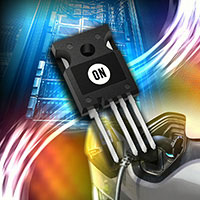
significantly better performance in applications such as Electric Vehicles (EV) On-Board Chargers (OBC), solar inverters, server Power Supply Units (PSU), telecoms and Uninterruptible Power Supplies (UPS).
Commenting on the new releases, Asif Jakwani, Senior Vice President of the Advanced Power Division at ON Semiconductor said: “In modern power applications such as OBC for EV and other applications including renewable energy, enterprise computing and telecom, efficiency, reliability and power density are constant challenges for designers.
“These new SiC MOSFETs significantly improve performance over the equivalent silicon switching technologies, allowing engineers to meet these challenging design goals. The enhanced performance delivers lower losses that enhance efficiency and reduce thermal management needs as well as reducing EMI. The end result of using these new SiC MOSFETs is a smaller, lighter, more efficient and more reliable power solution.”
2. Alpha and Omega Semiconductor has introduced two application-specific EZBuck regulators, designed to support VCCIN_Aux rails in Intel Tiger Lake processors. The AOZ2264VQI and AOZ2369VQI buck regulators have adjustable output voltage capability using 2-bit voltage identification (VID) for a high power density to support Intel’s dual rail Tiger Lake platform. Input voltage range is 4.0 to 28V.
The buck regulators are offered in a QFN 4 x 4 (AOZ2264VQ) and QFN 5 x 5 package (AOZ2369VQI). They are claimed to offer the industry’s most compact footprint to support VCCIN_AUX rails in Intel Tiger Lake platforms which are used in notebook and desktop computing systems.
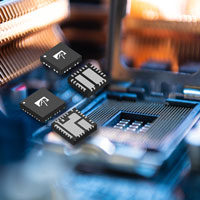
“The two current capabilities offered by the AOZ2264VQI and the AOZ2369VQI offer designers a scalable solution to support Intel Tiger Lake’s multiple platform SKUs such as UP3, UP4, and H-Line,” said Wayne Lee, Power IC marketing at AOS.
Intel designed Tiger Lake with a rail to power the core and graphics processors, and a VCCIN_AUX rail to power the auxiliary processor. It is this auxiliary processor which supports add-on features in PCs, such as audio, video and connectivity. These typically require a VCC_AUX rail with high currents.
The 2-bit VID pins allow the VCCIN_AUX power rail to adjust with voltage for 0V, 1.1V, 1.65V, and 1.8V depending on multiple systems operating modes.
3. Nexperia has announced a series of half-bridge (high side & low side) automotive MOSFETs constructed in the space-saving LFPAK56D package format. The half-bridge configuration of two MOSFETS is a standard building block for many automotive applications including motor drives and DC/DC converters.
The new package provides a half-bridge solution in one device, occupying 30% lower PCB area compared to dual MOSFETs for three-phase motor control topologies due to the removal of PCB tracks, whilst permitting simple Automated Optical Inspection (AOI) during production.
The LFPAK56D half-bridge utilises existing high volume LFPAK56D assembly processes with proven automotive reliability. The package format uses flexible leads to improve overall reliability, and an internal copper clip connection between the MOSFETs simplifies PCB designs and brings a plug and play style solution with exceptional current handling capability of 98A.
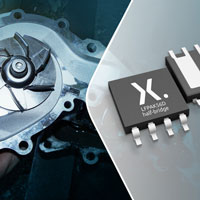
Typically, in a half-bridge arrangement, the PCB connection between the source of the high side MOSFET and the drain of the low side MOSFET can create a significant amount of parasitic inductance. However, with its internal clip connection, the LFPAK56D half-bridge package achieves 60% less inductance.
The new LFPAK56D half-bridge MOSFETs launched are the BUK7V4R2-40H and the BUK9V13-40H. Both utilise the highly robust Trench 9 automotive silicon process technology, are rated at 40V and are verified at twice the automotive AEC-Q101 specification in key tests. RDS(on) of the devices measures 4.2 mOhm (BUK7V4R2) and 13 mOhm (BUK9V13).
4. As reliance on communication and weather satellites grows and space research expands in scope and mission, new technology is required to help speed spaceflight system design and production. Microchip Technology has announced the expansion of its SA50-120 power converter family with nine new units based on its Commercial Off-the-Shelf (COTS) technology. This technology provides developers with space-qualified power converters that help to minimise risk and lower development costs.
Microchip’s SA50-120 radiation-hardened DC to DC power converters - standard non-hybrid space-grade DC/DC power converters - utilise surface mount component construction, allowing flexibility and customisation to fit specific applications and requirements. The SA50-120 family, qualified to Mil-Std-461, Mil-Std-883 and Mil-Std-202, enables designers to start with proven COTS technology and quickly scale up development, reducing risk and development time.
SA50-120 power converters utilise 120V input and offer up to 56W of output in a low profile, small-sized solution. These EMI compliant and radiation-hardened designs with single and triple outputs are ideal for Space Station and ORION program platforms. The units utilise switching regulators that use peak current mode controlled single-ended forward converter topology with inherent single-event immunity.
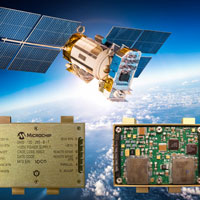
Offering eight million hours Mean Time Between Failure (MTBF) and up to 87% efficiency – the highest of any standard 120V input space-grade DC-DC power converter, the SA50-120 maximises system performance and reliability. The units are qualified to 100 krad (Si) Total Ionisation Dose (TID) and Single Event Effects (SEE) greater than 80 MeV cm2/mg, and offer synchronisation, a Transitor-Transitor Logic (TTL) on/off command signal, and various protection features. Single output versions additionally offer remote sense, output voltage adjust and parallel connection functions.
Microchip’s 30-year legacy as a space technology partner spans more than 50 successful programs and platforms,” said Leon Gross, Vice President of Microchip’s Discrete Products Group business unit. “We continue to invest in the development of critical technology required for spaceflight.”
5. Texas Instruments has introduced a highly integrated Grade 0 brushless DC (BLDC) motor driver for 48V high-power motor control systems, such as traction inverters and starter generators in mild hybrid electric vehicles (MHEVs).
The DRV3255-Q1 can help designers shrink their motor system size by as much as 30%, while providing a high gate-drive current for increased protection and output power. Meeting the most stringent safety requirements, the new motor driver was designed according to TI’s TÜV SÜD-certified functional safety development process, helping enable up to Automotive Safety Integrity Level (ASIL) D.
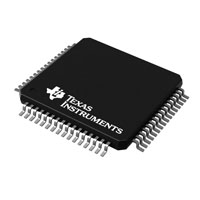
A 48V system is a step-change that Original Equipment Manufacturers [OEMs] can implement to meet goals around reducing emissions, while also adding power for advanced driver-assistance system features and managing power-hungry loads such as the heating, ventilation and air conditioning system,” said Asif Anwar, Director of the powertrain, body, chassis and safety service at Strategy Analytics. “Combining leading-edge performance characteristics with functional safety and Grade 0 translates to real-world, system-level operational benefits that will help OEMs achieve these goals.”


